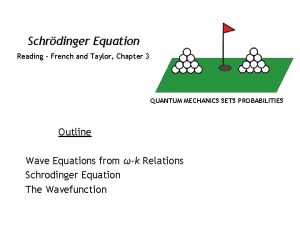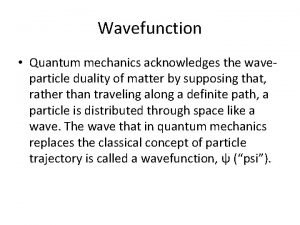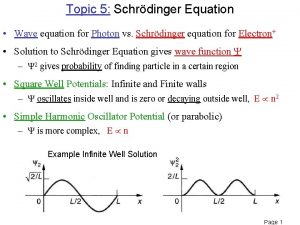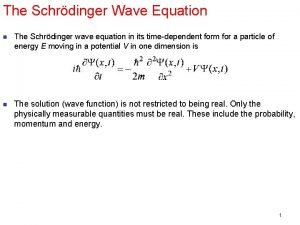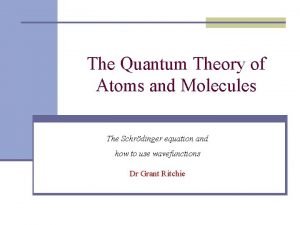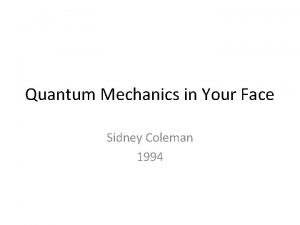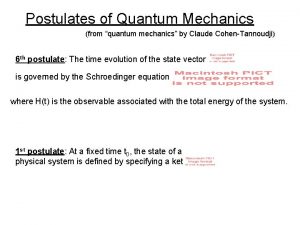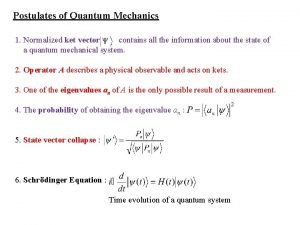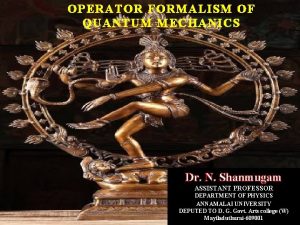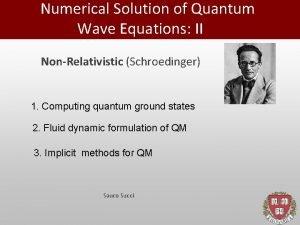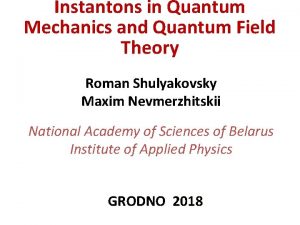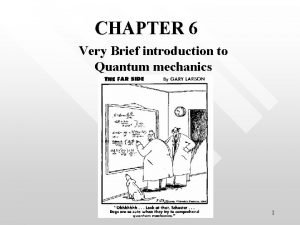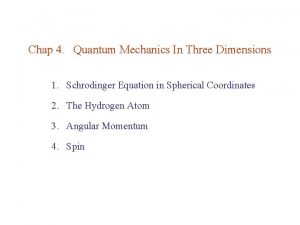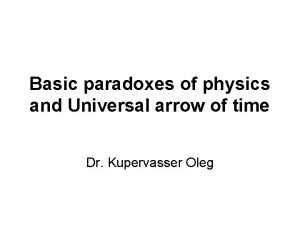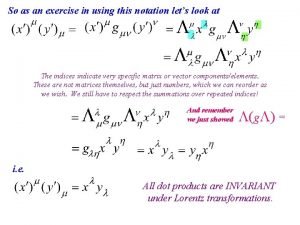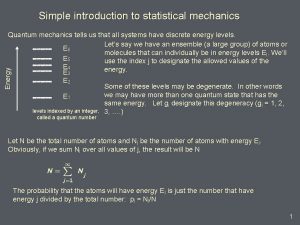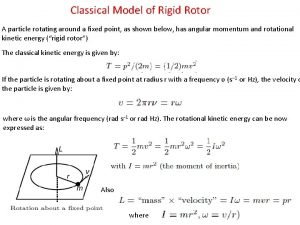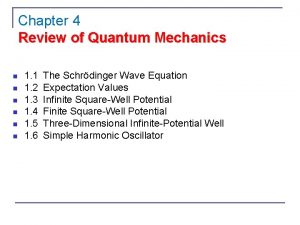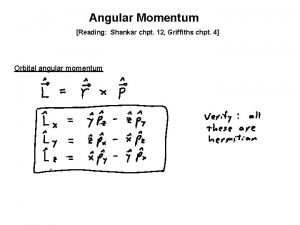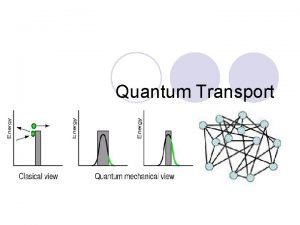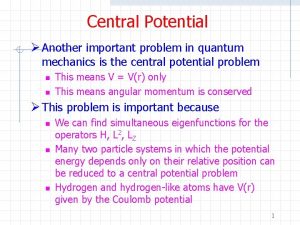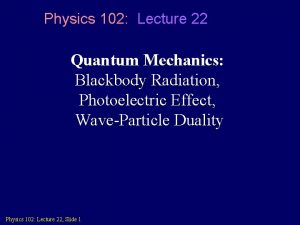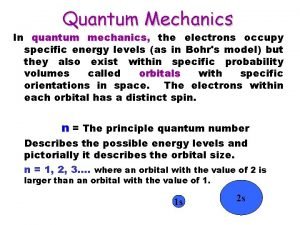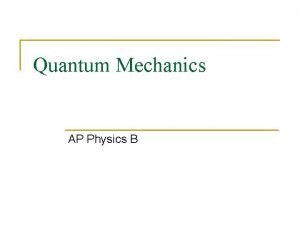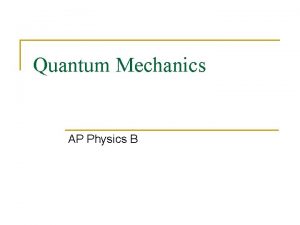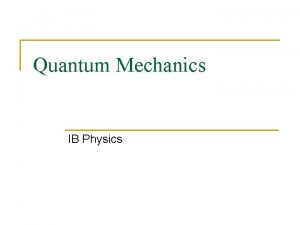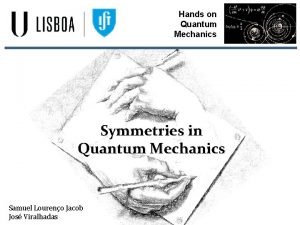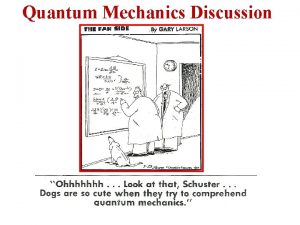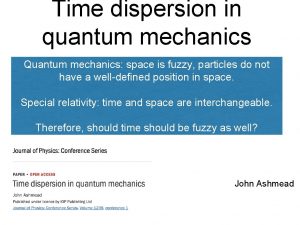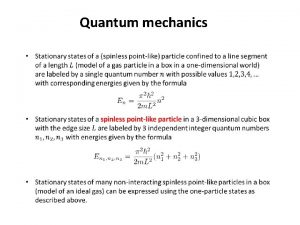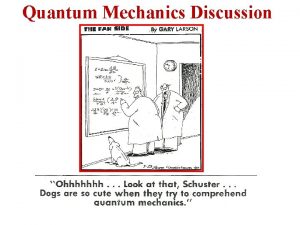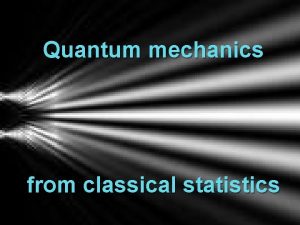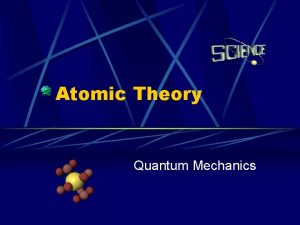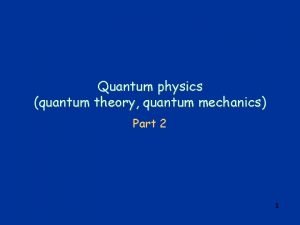Electrons and Quantum Mechanics Unit 5 Electrons Rutherford



































- Slides: 35

Electrons and Quantum Mechanics Unit 5

Electrons • Rutherford described the dense center of the atom called the nucleus. • But the Electrons spin around the outside of that nucleus. – Provide the chemical properties of the atoms. – Responsible for color and reactivity.

Energy • Energy is transmitted from one place to another. – Light carries this energy. – Converted into heat. • Light is called Electromagnetic Radiation.

Electromagnetic Spectrum • Radio • Infrared • Visible Light – ROY G BIV • Ultraviolet • X Rays • Gamma Rays

Light • Light travels as a wave. • Wave Properties – Wavelength (λ) = distance between two waves (m) – Frequency (f) = number of peaks per second (Hz) – Speed of Light (c) = how fast light moves.

Light • Light Equation c= ƒλ • Speed of light is a constant = 3 x 108 m/s • Nothing travel faster than the speed of light! – Maybe? !? !?

Light • The Dual Nature of Light – Light carries energy through space like a wave. – Light also behaves like a particle? !? • A beam of light is made of tiny packets of energy called PHOTONS! • Which travel in waves!? !

Light • The Energy of a photon depends on its frequency. – So is the color of light!!! E = hƒ • ELECTRONS are like photons! – Act as waves and particles. – Orbit the nucleus in a wave -like motion.

Blackbody Radiation • Rutherford could never explain why objects change colors when they are heated. • As the object heats, it must give off electrons of certain frequencies and energies.

Photoelectric Effect • Similarly, light on a metal object can knock off electrons. – Shine different colors on a metal. – Measure the number of electrons knocked off. – Found that no electrons were knocked off below a certain frequency.

The Bohr Model • Proposed the electrons orbit the nucleus with fixed energies. – Called Energy Levels – Much like the rungs of a ladder. • Quantum describes the amount of energy required to move an electron from one level to another.

The Bohr Model • Ground State – Lowest possible energy of an electron. – Normal location • Excited State – If electron absorbs energy, it moves up an energy level (absorption) – If an electron gives off energy, it moves down an energy level (emission).

The Bohr Model

Atomic Spectra • Hydrogen Atom Line Emission Spectrum – Expected continuous spectrum of light – But only specific frequencies were given off. • • Red (656. 6 nm) Blue-green (486. 1 nm) Violet (434. 1 nm) Violet (419. 2 nm)

Atomic Spectra • Shine a light on an Atom – When atoms absorb energy, electrons move to higher energy levels. – When atoms release the energy, electrons return to the lower energy level. • Atomic Spectra – Frequencies of light emitted by a certain element. – No two elements have the same spectrum. http: //student. fizika. org/~nnctc/spectra. htm

Flame Tests • Because no two atoms produce the same spectrum, elements can be identified by the colors they emit. • Spectral Analysis uses this properties to identify elements.

Quantum Mechanics • Max Planck (1900) – Founder of Quantum Mechanics E = hf • Albert Einstein (1905) – Wave-Particle Duality – Electrons are small particles that move like waves.

Quantum Mechanics • Neils Bohr (1922) – Electrons orbit in distinct energy levels. • Louis de Brogelie (1923) – Wave Mechanics says that ALL MATTER behaves like waves. mv/λ = h

Quantum Mechanics • Werner Heisenberg (1927) – Principle of Indeterminacy – You can’t know both the position and the velocity of an electron. • Erwin Schrödinger (1930) – Used wave mechanics to show the PROBABLE location of an electron. – Electrons exist in 3 D clouds of probability!!!


Quantum Mechanical Model • Uses Schrodinger’s equation to predict the probable location of an electron. – Determines the energies an electron is allowed to have. – Determines how likely it is to find the electron in various locations around the nucleus.

Quantum Numbers • Describes the location and behavior of an electron – Like an electron’s address – No two electrons can have the same quantum numbers. • Four Numbers

Quantum Numbers • Principle (1 st) Quantum Number (n) – The Energy Level – Describes the size of the cloud and the distance of the cloud from the nucleus. – Shows the number of electrons n = 1 = 2 electrons n = 2 = 8 en = 3 = 18 en = 4 = 32 e-


Quantum Numbers • 2 nd Quantum Number (l) – Each energy level has sublevels. – The number of sublevels equals n. – Sublevels are called: s = spherical p = peanut-shaped d = daisy-shaped f = unknown?


Quantum Numbers • 3 rd Quantum Number (ml) – Divides sublevels into orbitals. – Tells the shape the electron moves in. – Number of orbitals = n 2 – Examples s = 1 orbital p = 3 orbitals d = 5 orbitals f = 7 orbitals

Quantum Numbers • 4 th Quantum Number (ms) – Describes the electron’s spin. – Only two electrons fit in an orbital. – Their charges repel causing them to spin in opposite directions (+½ or –½) – Use up and down arrows.


Quantum Numbers • Pauli Exclusion Principle – No two electrons can have the same set of 4 quantum numbers. – The electrons repel each other. • Hund’s Rule – Every orbital must get one electron before doubling up.

Quantum Numbers • Diagonal Rule – Electrons fill orbitals in predictable patterns – Some People Do Forget – Electrons dill the lowest energy level possible. 1 s 2 s 3 s 4 s 5 s 2 p 3 p 4 p 5 p 3 d 4 d 5 d 4 f 5 f

Orbital Notation • Draw out the locations of each electron in an atom with arrows.

Electron Configuration • Write out the configurations of electrons using superscripts. • Examples: – H = 1 s 1 – He = 1 s 2

Electron Configurations • Noble Gas Shorthand – Write the Noble Gas just before the element. – Add the remainder of the configuration.

Lewis Dot Diagrams • A way to show the number and position of the valence electrons. – Outermost energy level – Look at the column number to get this number. • Use the chemical symbol and number of valence electrons. – All four sides must have a dot before you double up. p orbitals s orbital p 1 p 2 X p 3 s
 Quantum physics vs quantum mechanics
Quantum physics vs quantum mechanics Quantum physics vs quantum mechanics
Quantum physics vs quantum mechanics Schrodingers cay
Schrodingers cay The lowest allowable energy state of an atom
The lowest allowable energy state of an atom Electrons in atoms section 2 quantum theory and the atom
Electrons in atoms section 2 quantum theory and the atom Eigenfunction
Eigenfunction Schrodinger wave equation
Schrodinger wave equation Expectation value in quantum mechanics
Expectation value in quantum mechanics Expectation value in quantum mechanics
Expectation value in quantum mechanics Quantum mechanics in your face
Quantum mechanics in your face Chemistry
Chemistry Postulates of quantum mechanics
Postulates of quantum mechanics Site:slidetodoc.com
Site:slidetodoc.com Operators in quantum mechanics
Operators in quantum mechanics Dr susan cartwright
Dr susan cartwright Operator formalism in quantum mechanics
Operator formalism in quantum mechanics Equation of continuity in quantum mechanics
Equation of continuity in quantum mechanics Beta decay
Beta decay Instantons
Instantons Expectation value in quantum mechanics
Expectation value in quantum mechanics Operators in quantum mechanics
Operators in quantum mechanics Quantum mechanics in three dimensions
Quantum mechanics in three dimensions Quantum mechanics basics
Quantum mechanics basics Grandfather paradox
Grandfather paradox Commutation relation in quantum mechanics
Commutation relation in quantum mechanics Introduction to quantum statistical mechanics
Introduction to quantum statistical mechanics Mark tame
Mark tame Commutation relation in quantum mechanics
Commutation relation in quantum mechanics Rigid rotor quantum mechanics
Rigid rotor quantum mechanics Review of quantum mechanics
Review of quantum mechanics Griffiths
Griffiths Transfer matrix quantum mechanics
Transfer matrix quantum mechanics Littlejohn quantum mechanics
Littlejohn quantum mechanics Quantum mechanics powerpoint
Quantum mechanics powerpoint Central potential in quantum mechanics
Central potential in quantum mechanics Quantum mechanics
Quantum mechanics


